Unplugged: GamerDad Holiday Guide 2021
 Happy Holidays! Boardgaming continues to make inroads to wider audiences, and there’s no better time to get (or get your friends and family) into the hobby than an extended holiday break. It is yet another “unusual” year so there may not be as much mixing in your neck of the woods but there are boardgames out there to meet up with almost any taste. If you only have access to online gaming buddies, check out BoardGameArena.com or TableTopia.com. Boardgames are timeless, just as good today as they will be years in the future, so a purchase today will still be serving you well after the lockdowns go away. As we at GamerDad have done for the past 18+ years, it’s time for an annual rundown of recent boardgames well worth your time. Feel free to delve into some past year’s guides for 2020, 2019, 2018, or older as they’re still great candidates for your consideration. You might not find all these titles at your local mega-mart but many can be found online or in a friendly local game store. Some may argue $60+ boardgames are expensive, but compare that to video gaming (and where multiple copies are required for multiplayer play) and the economics of boardgaming shows their true value. For each game I’ve provided the publisher (to help you find it), an approximate MSRP (you might find it lower), the number of players, the expected time for one game, and the manufacturer’s recommended ages (and I would say most of these could easily be skewed lower for experienced younger gamers.
Happy Holidays! Boardgaming continues to make inroads to wider audiences, and there’s no better time to get (or get your friends and family) into the hobby than an extended holiday break. It is yet another “unusual” year so there may not be as much mixing in your neck of the woods but there are boardgames out there to meet up with almost any taste. If you only have access to online gaming buddies, check out BoardGameArena.com or TableTopia.com. Boardgames are timeless, just as good today as they will be years in the future, so a purchase today will still be serving you well after the lockdowns go away. As we at GamerDad have done for the past 18+ years, it’s time for an annual rundown of recent boardgames well worth your time. Feel free to delve into some past year’s guides for 2020, 2019, 2018, or older as they’re still great candidates for your consideration. You might not find all these titles at your local mega-mart but many can be found online or in a friendly local game store. Some may argue $60+ boardgames are expensive, but compare that to video gaming (and where multiple copies are required for multiplayer play) and the economics of boardgaming shows their true value. For each game I’ve provided the publisher (to help you find it), an approximate MSRP (you might find it lower), the number of players, the expected time for one game, and the manufacturer’s recommended ages (and I would say most of these could easily be skewed lower for experienced younger gamers.
Games for and With Kids
Games suitable for kids old enough to sit still and play, but contain enough interesting activity to entertain adults.
Disney You can Fly! (Funko – $17) 2-4p 20 min (any age)
 More of an activity than a game, but a fun way to move around during the indoor winter months. A “course” of up to 8 flags are scattered around the house. Then each player receives a disney-themed (Dumbo, Buzz, Tinkerbell…) thick styrofoam glider to throw. Players attempt to throw their glider to be closest to the next flag. The closest player “wins” the flag and play proceeds to the next flag. Two things “shake up” the game. Each new flag has a rule that affects how that section is played. Things include throwing blind, throwing with your feet, throwing under your leg, throwing the airplane upside down, etc… The winner of one segment of the race must then play one of their three bonus cards – which give an advantage to all the other players in the next round. They can either take a step before throwing, ignore the special requirements of that segment, or have the opportunity of a re-do for their throw. The bonus cards are a great, unobtrusive way to help give a bit of a boost to the players who may be falling behind in the scoring.
More of an activity than a game, but a fun way to move around during the indoor winter months. A “course” of up to 8 flags are scattered around the house. Then each player receives a disney-themed (Dumbo, Buzz, Tinkerbell…) thick styrofoam glider to throw. Players attempt to throw their glider to be closest to the next flag. The closest player “wins” the flag and play proceeds to the next flag. Two things “shake up” the game. Each new flag has a rule that affects how that section is played. Things include throwing blind, throwing with your feet, throwing under your leg, throwing the airplane upside down, etc… The winner of one segment of the race must then play one of their three bonus cards – which give an advantage to all the other players in the next round. They can either take a step before throwing, ignore the special requirements of that segment, or have the opportunity of a re-do for their throw. The bonus cards are a great, unobtrusive way to help give a bit of a boost to the players who may be falling behind in the scoring.
Dungeons & Dragons: Dungeon Scrawlers – Heroes of Undermountain (Wizkids – $25 ) 2-4p 15 min 10+ yrs
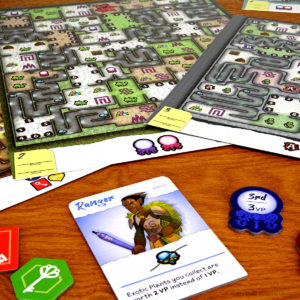 Dungeon Scrawlers is a sort of real time maze solving with objectives along the way. The backstory is that players are adventurers about to set foot into a dangerous dungeon to explore and loot along the way. Players then take a dry-erase marker and proceed to draw a path through the laminated board (without ever picking the marker up off the page.) Along the way there are images in each room which need to be dealt with. Goblins need to be scribbled out, treasures need to be circles, magical runes need to be traced over, etc… Players earn points for each object they interact with (provided they do so in the correct manner.) At the “end” of the maze (there are multiple routes that interweave) is a large “boss” monster that must be fully scribbled out. The first player to completely scribble out the boss monster calls time and everyone puts their markers down. Players then exchange cards and add up their opponents’ scores, taking care to note if a player makes a mistake. Interacting with a room incorrectly nullifies points, but cutting through a wall in the maze is a big penalty. While the boss is worth a pile of points, it is by no means a guaranteed win. The game gives each player a special power (typically allowing them to ignore or reduce the effort of interacting with specific features of the maze) and there are 10 different dungeon mazes to explore. These increase in complexity. At first it is a simple race through a maze, with later mazes including portals to hop between sections of the board or locked gates that first require retrieval of a specific coded key. While listed at ages 10+, the less complex mazes are easily played by the younger set, making it a fun choice for a kid/adult game.
Dungeon Scrawlers is a sort of real time maze solving with objectives along the way. The backstory is that players are adventurers about to set foot into a dangerous dungeon to explore and loot along the way. Players then take a dry-erase marker and proceed to draw a path through the laminated board (without ever picking the marker up off the page.) Along the way there are images in each room which need to be dealt with. Goblins need to be scribbled out, treasures need to be circles, magical runes need to be traced over, etc… Players earn points for each object they interact with (provided they do so in the correct manner.) At the “end” of the maze (there are multiple routes that interweave) is a large “boss” monster that must be fully scribbled out. The first player to completely scribble out the boss monster calls time and everyone puts their markers down. Players then exchange cards and add up their opponents’ scores, taking care to note if a player makes a mistake. Interacting with a room incorrectly nullifies points, but cutting through a wall in the maze is a big penalty. While the boss is worth a pile of points, it is by no means a guaranteed win. The game gives each player a special power (typically allowing them to ignore or reduce the effort of interacting with specific features of the maze) and there are 10 different dungeon mazes to explore. These increase in complexity. At first it is a simple race through a maze, with later mazes including portals to hop between sections of the board or locked gates that first require retrieval of a specific coded key. While listed at ages 10+, the less complex mazes are easily played by the younger set, making it a fun choice for a kid/adult game.
Party Games
The more, the merrier! Party games can accommodate at least 6 players and, unlike some games, tend to be more fun with more players. If you’re only aware of Charades (a classic) or Trivial Pursuit (only fun for know-it-alls) checking out some of these more engaging games will be a real treat.
Ultimate Werewolf Extreme (Bézier Games – $25) 3-25p 30-60min 8+ yrs
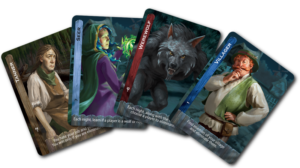 The hidden-role game of Werewolf is commonly known. Players are secretly assigned to be townspeople or werewolves and then the group begins to discuss who those secret werewolves might be. The group picks someone (hopefully a werewolf) each round to eliminate from the game. Meanwhile, there is a “night” phase each round where the werewolves secretly pick someone to kill off, and that (usually townsperson) is also eliminated from the game. Thus, the werewolves win if they outnumber the villagers and the villagers win when eliminating all the werewolves. One person serves as the moderator so as to communicate between the wolves and the people (indicating who gets bumped off in the night…) The game is easy enough to set up with a deck of playing cards, but what “Ultimate Werewolf Extreme” brings to the table is a bunch of extra options for players. A common extra role is a Seer player who can ask the moderator each night if a specific player is a wolf or not. A bodyguard can designate someone each round to be immune to the werewolves’ attack. While these are common additions, UWE has many, many other role options to mix things up and give different styles of gaming experiences. You can keep things simple or give almost everyone some sort of bonus ability. These can quickly add up and make things complicated for the moderator. Bézier games has your back, though, as they’ve created a Werewolf app that can be used to keep track of all the roles, when they act, and what they get to do.
The hidden-role game of Werewolf is commonly known. Players are secretly assigned to be townspeople or werewolves and then the group begins to discuss who those secret werewolves might be. The group picks someone (hopefully a werewolf) each round to eliminate from the game. Meanwhile, there is a “night” phase each round where the werewolves secretly pick someone to kill off, and that (usually townsperson) is also eliminated from the game. Thus, the werewolves win if they outnumber the villagers and the villagers win when eliminating all the werewolves. One person serves as the moderator so as to communicate between the wolves and the people (indicating who gets bumped off in the night…) The game is easy enough to set up with a deck of playing cards, but what “Ultimate Werewolf Extreme” brings to the table is a bunch of extra options for players. A common extra role is a Seer player who can ask the moderator each night if a specific player is a wolf or not. A bodyguard can designate someone each round to be immune to the werewolves’ attack. While these are common additions, UWE has many, many other role options to mix things up and give different styles of gaming experiences. You can keep things simple or give almost everyone some sort of bonus ability. These can quickly add up and make things complicated for the moderator. Bézier games has your back, though, as they’ve created a Werewolf app that can be used to keep track of all the roles, when they act, and what they get to do.
Spaceteam: A Chaotic and Cooperative Card Game (Stellar Factory – $28) 3-6p 5 min, 10+ yrs
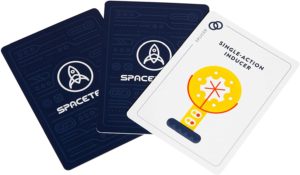 Spaceteam, (if you haven’t played it, you should) is a fun little phone app where several people cooperate to “save their ship.” This is done by people looking at their phones and shouting at other people to perform silly actions with strange labels. “Flip the jibber womp, you fool!” Spaceteam is now also a card game. In this version, a set of “tool” cards are distributed to all players. Each player is then given a deck of problem cards. Each of these cards either require that player to obtain and play a specific set of tool cards or the card can require a player (or the group) to perform a strange action. Some affect the entire group – like exchanging cards or touching one another, while others affect only the individual – may not use thumbs, or cannot speak until specific conditions are met. The players simultaneously try to complete their problem decks with the shared goal of the group to complete all the problem cards before the time runs out. The difficulty of the game can be increased or decreased depending on the number and type of cards placed into the problem decks.
Spaceteam, (if you haven’t played it, you should) is a fun little phone app where several people cooperate to “save their ship.” This is done by people looking at their phones and shouting at other people to perform silly actions with strange labels. “Flip the jibber womp, you fool!” Spaceteam is now also a card game. In this version, a set of “tool” cards are distributed to all players. Each player is then given a deck of problem cards. Each of these cards either require that player to obtain and play a specific set of tool cards or the card can require a player (or the group) to perform a strange action. Some affect the entire group – like exchanging cards or touching one another, while others affect only the individual – may not use thumbs, or cannot speak until specific conditions are met. The players simultaneously try to complete their problem decks with the shared goal of the group to complete all the problem cards before the time runs out. The difficulty of the game can be increased or decreased depending on the number and type of cards placed into the problem decks.
Family Games
As your family gets older, they’ll have more fun with games with a bit more “punch”. Games in this category are playable by most any age level (so even the young ones can participate) but have enough strategy so that the older players have a chance to use strategy to increase their chances of winning.
Railroad Ink Challenge (Horrible Guild – $20) 1-4p 15-30min 8+ yrs
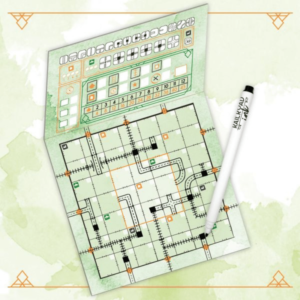 Railroad Ink has previously appeared in Holiday Guide 2018, but a new Railroad Ink Challenge version came out earlier this year. The two share the same basic concept. Four dice are rolled to display a square section of roads, railways, and/or intersections. Players draw these squares onto their player board, hoping to make long roads/rails, connect up the sides of the board, and set up other scoring situations. Railroad Ink Challenge takes the basic gameplay and changes up the rules slightly. Now, a set of goal cards are added to the mix. These are an additional way to gain points but only go to the first player to accomplish them. This adds just a slice of player interaction which is absent (for good or ill) in the original game. In addition, the challenge edition has slightly more diverse options on the faces of the dice and has special buildings that start the game on the game grid. These new buildings provide another source of points but because they also help fill in the grid, players’ grids tend to be more filled in at the end of a game. Railroad Ink Challenge comes in two colors, green and yellow. (Just like the original came in blue and red.) The two are equivalent, except each has two special colored dice. One of these can be used along with the basic die to slightly change how a game is played. The green one has players drawing in trees to form large groups or drawing in trails (a third network) that moves along corners. Railroad Ink Challenge Yellow/Green is a step up in complexity (a small one) from Blue/Red but the addition of goals brings more direct player competition and makes for a more entertaining solo game. Note, Green/Yellow only has cards for 4 players (8 if you have both colors) but one can make laminated photocopies for more which removes a player limit entirely. (Well, you may need to fiddle with goal parts a bit…)
Railroad Ink has previously appeared in Holiday Guide 2018, but a new Railroad Ink Challenge version came out earlier this year. The two share the same basic concept. Four dice are rolled to display a square section of roads, railways, and/or intersections. Players draw these squares onto their player board, hoping to make long roads/rails, connect up the sides of the board, and set up other scoring situations. Railroad Ink Challenge takes the basic gameplay and changes up the rules slightly. Now, a set of goal cards are added to the mix. These are an additional way to gain points but only go to the first player to accomplish them. This adds just a slice of player interaction which is absent (for good or ill) in the original game. In addition, the challenge edition has slightly more diverse options on the faces of the dice and has special buildings that start the game on the game grid. These new buildings provide another source of points but because they also help fill in the grid, players’ grids tend to be more filled in at the end of a game. Railroad Ink Challenge comes in two colors, green and yellow. (Just like the original came in blue and red.) The two are equivalent, except each has two special colored dice. One of these can be used along with the basic die to slightly change how a game is played. The green one has players drawing in trees to form large groups or drawing in trails (a third network) that moves along corners. Railroad Ink Challenge Yellow/Green is a step up in complexity (a small one) from Blue/Red but the addition of goals brings more direct player competition and makes for a more entertaining solo game. Note, Green/Yellow only has cards for 4 players (8 if you have both colors) but one can make laminated photocopies for more which removes a player limit entirely. (Well, you may need to fiddle with goal parts a bit…)
Machi Koro 2 (Pandasaurus Games – $30) 2-5p 45min 10+ yrs
 My son loves Machi Koro, it’s what one would get if you took the board out of Monopoly and focused entirely on the properties. Players buy cards which pay out when a given number is rolled. This could be on one’s own turn, on anyone’s turn, or possibly only on another player’s turn (typically you are stealing money from them.) The goal is to purchase a specific set of increasingly expensive cards that provide special abilities rather than opportunities for income. The sequel, Machi Koro 2, has identical gameplay. However, the game is slightly more streamlined and has some of the rough edges filed off. Rather than having all the cards available to buy (or randomly determined if using expansions) as in the original game, Machi Koro 2 has three decks of cards from which to draw. These correspond to specific numbers on the dice, so it is much easier for a player to buy cards of the numbers they prefer. While the original is great, Machi Koro 2 is even better. The sequel isn’t a need-to-buy for Machi Koro owners, but Machi Koro 2 is a great family game.
My son loves Machi Koro, it’s what one would get if you took the board out of Monopoly and focused entirely on the properties. Players buy cards which pay out when a given number is rolled. This could be on one’s own turn, on anyone’s turn, or possibly only on another player’s turn (typically you are stealing money from them.) The goal is to purchase a specific set of increasingly expensive cards that provide special abilities rather than opportunities for income. The sequel, Machi Koro 2, has identical gameplay. However, the game is slightly more streamlined and has some of the rough edges filed off. Rather than having all the cards available to buy (or randomly determined if using expansions) as in the original game, Machi Koro 2 has three decks of cards from which to draw. These correspond to specific numbers on the dice, so it is much easier for a player to buy cards of the numbers they prefer. While the original is great, Machi Koro 2 is even better. The sequel isn’t a need-to-buy for Machi Koro owners, but Machi Koro 2 is a great family game.
Super Mega Lucky Box (Gamewright – $16) 1-6p 20min 8+ yrs
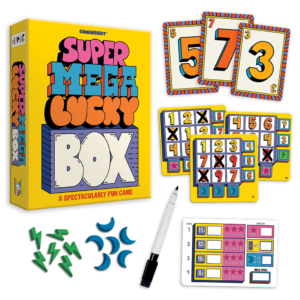 Roll and write games are extremely popular right now and Super Mega Lucky Box is a very family-friendly example of the genre. In typical roll & write games, a set of dice are rolled and everyone then uses the same dice to mark on their private board in order to accomplish goals and score points (as in Railroad Ink Challenge, mentioned above.) Rather than a single scoresheet, Super Mega Lucky Box breaks things into multiple small cards made of a 3×3 grid of numbers. Someone rolls the dice, and then people simply cross out numbers based on the results. Fill in a row or column on a card to gain a special power. This can include a free X on another card, the opportunity to adjust a die at a later moment, gain a resource for end game scoring, etc… Players earn points as they fill in the cards with bonus points for completing any one card. To keep things simple, players start with three cards, but then gain more as the game progresses and cards are filled in. This helps on-board new players as there are fewer decisions at the start. Roll & Write games are inexpensive and imminent portable, and Super Mega Lucky Box is a great introduction to the genre.
Roll and write games are extremely popular right now and Super Mega Lucky Box is a very family-friendly example of the genre. In typical roll & write games, a set of dice are rolled and everyone then uses the same dice to mark on their private board in order to accomplish goals and score points (as in Railroad Ink Challenge, mentioned above.) Rather than a single scoresheet, Super Mega Lucky Box breaks things into multiple small cards made of a 3×3 grid of numbers. Someone rolls the dice, and then people simply cross out numbers based on the results. Fill in a row or column on a card to gain a special power. This can include a free X on another card, the opportunity to adjust a die at a later moment, gain a resource for end game scoring, etc… Players earn points as they fill in the cards with bonus points for completing any one card. To keep things simple, players start with three cards, but then gain more as the game progresses and cards are filled in. This helps on-board new players as there are fewer decisions at the start. Roll & Write games are inexpensive and imminent portable, and Super Mega Lucky Box is a great introduction to the genre.
Downforce (Restoration games – $25) 2-6p 20-40 min 10+ yrs
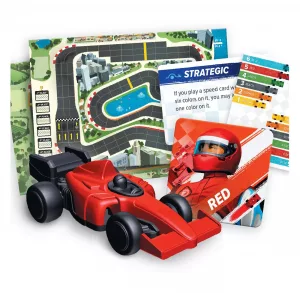 A racing game popular with the gaming crowd, now out in a less-expensive version available at Target. Players begin the game with a set of cards displaying numbers of various colors. Each color represents a car and the numbers represent the distance that card will move that particular color. After looking at their cards, players bid on which color cars they want to control (perhaps multiple cars when playing with fewer players.) Once cars are assigned, players take turns playing their cars and moving the appropriate colors (whether they own the cars or not.) The racetrack is narrow at points and inside lanes on curves have fewer boxes. Thus, much of the strategy relies on getting one’s car into a good position and blocking other cards behind. It isn’t just a race to the finish. At three points in the race players secretly bet on which car will win the race (it might be another player’s…) At the end of the race, players win money based on the placing of their car as well as any money received by betting on the eventual winner. Thus, it is possible (although unlikely) for the race winner to lose the game. (Betting becomes even more important for games with more players, as the betting payouts are much greater than can be won in the lower placement finishes.)
A racing game popular with the gaming crowd, now out in a less-expensive version available at Target. Players begin the game with a set of cards displaying numbers of various colors. Each color represents a car and the numbers represent the distance that card will move that particular color. After looking at their cards, players bid on which color cars they want to control (perhaps multiple cars when playing with fewer players.) Once cars are assigned, players take turns playing their cars and moving the appropriate colors (whether they own the cars or not.) The racetrack is narrow at points and inside lanes on curves have fewer boxes. Thus, much of the strategy relies on getting one’s car into a good position and blocking other cards behind. It isn’t just a race to the finish. At three points in the race players secretly bet on which car will win the race (it might be another player’s…) At the end of the race, players win money based on the placing of their car as well as any money received by betting on the eventual winner. Thus, it is possible (although unlikely) for the race winner to lose the game. (Betting becomes even more important for games with more players, as the betting payouts are much greater than can be won in the lower placement finishes.)
More At-Home Escape Rooms
Various “escape room in a box” lines of games continue to sell well and thus continue to be printed. The old lines continue but there are a few new entries of note in the crowded field. The Exit: The Game + Puzzle line (Kosmos) combines the Exit: The Game escape room games with a companion jigsaw puzzle that is integral to solving the case. Unsolved Case Files (Goliath Games) is more deduction/mystery focused as players search through documents, autopsy reports, interviews, and other objects while trying to solve a crime. Finally, the echoes (Ravensburger) line combines game elements like cards and a game board with scannable technology that will trigger audio clues via an app. Part of the puzzle lies in putting the audio clues into the correct sequence to solve the puzzle.
Family Strategy Games
These are great games for most families – or a group of adults looking for a medium-weight game to play casually around the table to end an evening. These are a notch up in complexity kid’s or party games, but are simple enough for teens or preteens to enjoy.
Fast & Furious: Highway Heist (Funko – $30) 2-4p, 60min 12+ yrs
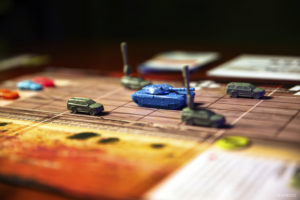 Fast & Furious: Highway Heist is a cooperative game set in the world of the famous movie franchise. It is sort of three games in one, with three scenarios available to play. Players are the main characters in the movie and set out to take down a tank, fight off a helicopter, or rob a moving semi truck, all set on the base game board made up of a section of highway. Each player is given a character with varying attributes as well as a vehicle that also has its own traits. Players roll dice based on their attributes (sometimes including the car’s as well) to see if they succeed or fail in their chosen actions. It is a very theatrical game, with players fighting it out while standing on top of cars, blowing holes in the side of a moving semi to steal what’s inside, etc… Players are even given a little peg to represent their character as they move around on top of cars or other vehicles during the game. Each scenario also has special optional goals to accomplish and meeting those goals rewards players with new abilities or resources to be used for the scenario goal. However, achieving all the goal cards is an alternate way to win the game. While the specific character tie-ins are a bit weak, fans of the movies will love the way the scenarios play out.
Fast & Furious: Highway Heist is a cooperative game set in the world of the famous movie franchise. It is sort of three games in one, with three scenarios available to play. Players are the main characters in the movie and set out to take down a tank, fight off a helicopter, or rob a moving semi truck, all set on the base game board made up of a section of highway. Each player is given a character with varying attributes as well as a vehicle that also has its own traits. Players roll dice based on their attributes (sometimes including the car’s as well) to see if they succeed or fail in their chosen actions. It is a very theatrical game, with players fighting it out while standing on top of cars, blowing holes in the side of a moving semi to steal what’s inside, etc… Players are even given a little peg to represent their character as they move around on top of cars or other vehicles during the game. Each scenario also has special optional goals to accomplish and meeting those goals rewards players with new abilities or resources to be used for the scenario goal. However, achieving all the goal cards is an alternate way to win the game. While the specific character tie-ins are a bit weak, fans of the movies will love the way the scenarios play out.
Cubitos (Alderac Entertainment Group – $60) 2-4p 30-60min 10+ yrs
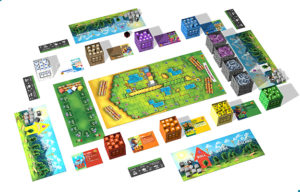 All the cube-shaped citizens of the land have come together to support their champion in a footrace. Players roll a personal pile of dice to generate movement for their runner who moves around the central board/racetrack. In addition to movement, dice can also grant other abilities such as coins or special actions. Coins can be used to buy more (and more powerful) dice which are then used in later turns. This steamrolls such that later rounds in the race can get quite epic in scope. There is a push-your-luck aspect in that players can reroll blank dice to get additional ability faces but if a reroll doesn’t add any new faces a player busts, losing all the faces they already generated. However, there is a consolation prize that grants some minor bonuses so even a busted turn helps out in the end. The game is set up to make sure no two games are ever alike. In addition to the two racetracks (one on each side of the board) there are 8 different colored sets of dice. The special ability of the action faces on these dice can change from game to game. In fact, the game comes with 7 possible versions of each color of dice. Gamers can play with entirely random sets, however the game has a large number of recommended combinations to make sure the game doesn’t go off the rails. I’m normally not a big fan of race games, but I do like my dice rolling and love the chance to play a game where I get to custom-purchase my strategy as I make my way through the game. Having a ton of variety for the same game is an added bonus.
All the cube-shaped citizens of the land have come together to support their champion in a footrace. Players roll a personal pile of dice to generate movement for their runner who moves around the central board/racetrack. In addition to movement, dice can also grant other abilities such as coins or special actions. Coins can be used to buy more (and more powerful) dice which are then used in later turns. This steamrolls such that later rounds in the race can get quite epic in scope. There is a push-your-luck aspect in that players can reroll blank dice to get additional ability faces but if a reroll doesn’t add any new faces a player busts, losing all the faces they already generated. However, there is a consolation prize that grants some minor bonuses so even a busted turn helps out in the end. The game is set up to make sure no two games are ever alike. In addition to the two racetracks (one on each side of the board) there are 8 different colored sets of dice. The special ability of the action faces on these dice can change from game to game. In fact, the game comes with 7 possible versions of each color of dice. Gamers can play with entirely random sets, however the game has a large number of recommended combinations to make sure the game doesn’t go off the rails. I’m normally not a big fan of race games, but I do like my dice rolling and love the chance to play a game where I get to custom-purchase my strategy as I make my way through the game. Having a ton of variety for the same game is an added bonus.
Tiny Epic Dinosaurs (Gamelyn Games – $25) 1-4p 30-60min 14+ yrs
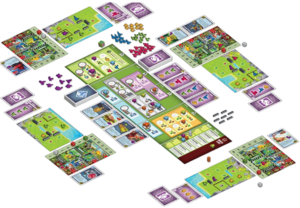 One to four players (there’s a solo mode) vy to collect and raise different types of dinosaurs in order to fulfill standing contracts for specific sets. It is a worker-placement game, meaning players take turns placing their worker pieces onto a central board area, performing the action next to that worker. During a round, spaces fill up so players must prioritize what they want to do so they aren’t blocked out by their opponents. Actions include gaining dinosaurs, fulfilling contracts, gaining special dino powers, and collecting food (yes, you need to keep those dinos fed.) Players must fit their dinos onto their ranch board, one per square, and fence them in. Dinos of two different colors can’t share the same fenced area. In an interesting balancing move, food and resources are gained at the start of a round based on the number of open ranch spaces. Thus, players have a disincentive to just let dinos lie around in their paddocks doing nothing. However, pairs of the same color dinos in the same pen will reproduce, granting a third dino of that type for free! What makes the game interesting is the addition of research cards that can be chosen. Some grant special general abilities, while others provide players with a unique, purple dinosaur (all purple dinos are different.) These can be used to fulfill contracts but they also grant a special power as long as they live on your ranch. It’s a meatier game than many others in the Tiny Epic line of games, but still very accessible. I love the price point and the very portable, tiny box. It has the table presence of a much larger box game because so much of the playing area is created by setting out oversized cards to form the various game elements. While small, the dino markers for each color are unique (and all the purple ones are unique shapes as well.) It all adds up to an impressive game coming from a very small box.
One to four players (there’s a solo mode) vy to collect and raise different types of dinosaurs in order to fulfill standing contracts for specific sets. It is a worker-placement game, meaning players take turns placing their worker pieces onto a central board area, performing the action next to that worker. During a round, spaces fill up so players must prioritize what they want to do so they aren’t blocked out by their opponents. Actions include gaining dinosaurs, fulfilling contracts, gaining special dino powers, and collecting food (yes, you need to keep those dinos fed.) Players must fit their dinos onto their ranch board, one per square, and fence them in. Dinos of two different colors can’t share the same fenced area. In an interesting balancing move, food and resources are gained at the start of a round based on the number of open ranch spaces. Thus, players have a disincentive to just let dinos lie around in their paddocks doing nothing. However, pairs of the same color dinos in the same pen will reproduce, granting a third dino of that type for free! What makes the game interesting is the addition of research cards that can be chosen. Some grant special general abilities, while others provide players with a unique, purple dinosaur (all purple dinos are different.) These can be used to fulfill contracts but they also grant a special power as long as they live on your ranch. It’s a meatier game than many others in the Tiny Epic line of games, but still very accessible. I love the price point and the very portable, tiny box. It has the table presence of a much larger box game because so much of the playing area is created by setting out oversized cards to form the various game elements. While small, the dino markers for each color are unique (and all the purple ones are unique shapes as well.) It all adds up to an impressive game coming from a very small box.
Adventure Games
A new category this year, games with a strong role-playing look and feel continue to flourish in the boardgame world. Perfect for gamers who want that role-playing feel without having to dedicate the dozens of hours needed to play traditional pencil and paper RPGs. These games run the gamut from simple and inexpensive to detailed and very expensive. Here is a sample cross-section.
Dungeons & Dragons: Adventure Begins (Hasbro – $25) 2-4p 10+ yrs
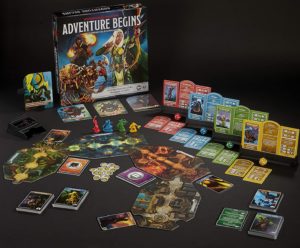 On the lightweight, lower priced end we have D&D: Adventure Begins. This is a short dungeon romp with a strong D&D theme. Players progress through three levels and then fight a boss monster. Players can collect gold along the way and halfway through players get to “level up” their character to make it more powerful. The game is in a bit of an oddball situation. In keeping with its attempt to introduce role playing to younger gamers, there is a fair bit of backstory “fluff” that can be fun to play make-believe but this is not further supported by the game-mechanics elements. For example, at the start you get to pick one of two weapons, but both have the same combat effects. It is listed for ages 10+, but most of the charm of the game comes from the story-based furnishings along the way and not from any of the mechanics or strategy. For kids 6-10 and their parents? This is a great game to introduce some of the basics of role playing.
On the lightweight, lower priced end we have D&D: Adventure Begins. This is a short dungeon romp with a strong D&D theme. Players progress through three levels and then fight a boss monster. Players can collect gold along the way and halfway through players get to “level up” their character to make it more powerful. The game is in a bit of an oddball situation. In keeping with its attempt to introduce role playing to younger gamers, there is a fair bit of backstory “fluff” that can be fun to play make-believe but this is not further supported by the game-mechanics elements. For example, at the start you get to pick one of two weapons, but both have the same combat effects. It is listed for ages 10+, but most of the charm of the game comes from the story-based furnishings along the way and not from any of the mechanics or strategy. For kids 6-10 and their parents? This is a great game to introduce some of the basics of role playing.
Stuffed Fables (Plaid Hat Games – $70) 2-4p 60-90min 7+ yrs
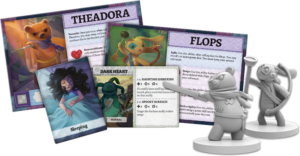 Taking a jump up in complexity (and price) is the extremely well-received Stuffed Fables. Part boardgame, part role playing game where gamers take on the role of stuffed animals on an adventure to save their child-owner from the clutches of the evil mastermind. The game focuses around an “adventure book” which opens up to lie flat on the table and serves as a map on one page with supplementary rules, story elements, and choices on the other page. On their turn, a player draws dice from a bag, with different colored dice keyed towards specific actions and options (white = restuff a character, red/green = attack, etc…) Black dice are also present and once enough have been drawn, the “bad guys” attack and the bag is reset. The game drips with the cuddly theme with touchstones of many common childhood milestones. It is cooperative and the game provides plenty of mechanics for players to help each other on their turns. The game lists 60-90 minutes playtime, but that is for a specific game session, not to complete the storybook. As an adventure game, it is at its best the first time through the story, but with dozens of different levels to play through there is still a lot of content – more if you want to seek out the expansion “Oh, Brother!” If you ever wanted to play a game where you were a part of the Toy Story movies, this is it.
Taking a jump up in complexity (and price) is the extremely well-received Stuffed Fables. Part boardgame, part role playing game where gamers take on the role of stuffed animals on an adventure to save their child-owner from the clutches of the evil mastermind. The game focuses around an “adventure book” which opens up to lie flat on the table and serves as a map on one page with supplementary rules, story elements, and choices on the other page. On their turn, a player draws dice from a bag, with different colored dice keyed towards specific actions and options (white = restuff a character, red/green = attack, etc…) Black dice are also present and once enough have been drawn, the “bad guys” attack and the bag is reset. The game drips with the cuddly theme with touchstones of many common childhood milestones. It is cooperative and the game provides plenty of mechanics for players to help each other on their turns. The game lists 60-90 minutes playtime, but that is for a specific game session, not to complete the storybook. As an adventure game, it is at its best the first time through the story, but with dozens of different levels to play through there is still a lot of content – more if you want to seek out the expansion “Oh, Brother!” If you ever wanted to play a game where you were a part of the Toy Story movies, this is it.
Descent: Legends of the Dark (Fantasy Flight / Asmodee – $175) 1-4 120-180min 14+ yrs
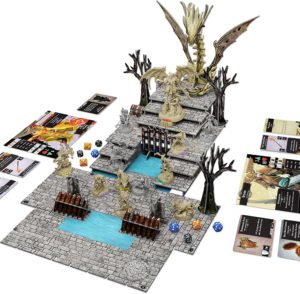 So you want to turn things up to eleven? Well, the complexity, price, and sheer number of plastic bits in Descent: Legends of the Dark is at least an eleven. (Yes, $175 for a board game, although you can easily find it for “only” $130 or less.) What you get here is a cubic foot of game box full of 46 pieces of 3D terrain, 40 plastic miniatures, piles of cardboard, and yes – a pretty decent adventure game that is explored over a campaign of 16 different quests. Along the way, players will be able to improve their characters over time via things like equipment upgrades, item crafting, shopping trips.. A companion app (yes, a phone/tablet or computer is required for play) keeps track of the overall campaign as well as assists in running individual quests. The basic gameplay leans towards the quick and fast (characters get to move and then choose two actions on their turn) at first but it quickly branches out into more complex decision trees as characters increase in power. Is it worth well over $100? Gamers willing to commit to the entire experience can expect at least 40 hours of gameplay. For fans of the genre (and the Descent boardgame in its previous incarnations,) that may be enough.
So you want to turn things up to eleven? Well, the complexity, price, and sheer number of plastic bits in Descent: Legends of the Dark is at least an eleven. (Yes, $175 for a board game, although you can easily find it for “only” $130 or less.) What you get here is a cubic foot of game box full of 46 pieces of 3D terrain, 40 plastic miniatures, piles of cardboard, and yes – a pretty decent adventure game that is explored over a campaign of 16 different quests. Along the way, players will be able to improve their characters over time via things like equipment upgrades, item crafting, shopping trips.. A companion app (yes, a phone/tablet or computer is required for play) keeps track of the overall campaign as well as assists in running individual quests. The basic gameplay leans towards the quick and fast (characters get to move and then choose two actions on their turn) at first but it quickly branches out into more complex decision trees as characters increase in power. Is it worth well over $100? Gamers willing to commit to the entire experience can expect at least 40 hours of gameplay. For fans of the genre (and the Descent boardgame in its previous incarnations,) that may be enough.
Serious Strategy Games
I typically mention a few games for the more serious boardgamer. These have a few more rules and take a bit longer to play. In a year of contrasts I’m featuring one fully cooperative game and two all-out wargames. None are as complex as past years’ serious strategy recommendations, but best played by people willing to put up with a few rules in order to find a game that has substance.
Clash of Cultures: Monumental Edition (Wizkids – $150) 2-4p 180-240min 14+ yrs
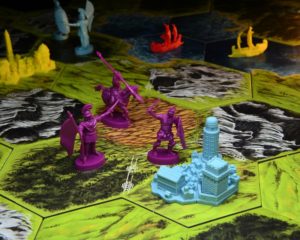 Another boardgame heading above the $100 mark, Clash of Cultures is a boardgame for fans of the Civilization video franchise (which itself derived from a boardgame…) As one might expect, players start off with a lowly town and a settler unit ready to go off and explore the world. In true 4X style, It has exploration (the board is revealed through play), expanding and exploiting through buildings, units, and researching a technology tree, and (attempted, at least) extermination of one’s opponents through combat. In a field of epic civilization-building games, Clash of Culture stands out in a few ways. Its map exploration uses smaller tiles than other games and thus provides a very nice sense of exploring the board, rather than having huge chunks of the world revealed all at once. It has a very open-ended technology tree, containing 12 categories of technology with each category having a single prerequisite before unlocking the rest of that category. This has a downside in that players are presented with a virtual wall of text on their first play. This is greatly lessened in further play. Finally, it manages to walk the line between totally abstracted combat and fiddly details. Its combat system does include dice but units are explicit pieces that march around the map so there is a direct correspondence to one’s army and what is showing on the board. Research tends to come into play at the start of each combat round where players are able to play a combat card that will augment their abilities for that round. Of course, Wizkids has put their plastic touch on the game so there is some nice eye candy of figurines representing armies and even cities, as city improvements are often physically added to the game board as plastic additions to show off how much your little village has grown.
Another boardgame heading above the $100 mark, Clash of Cultures is a boardgame for fans of the Civilization video franchise (which itself derived from a boardgame…) As one might expect, players start off with a lowly town and a settler unit ready to go off and explore the world. In true 4X style, It has exploration (the board is revealed through play), expanding and exploiting through buildings, units, and researching a technology tree, and (attempted, at least) extermination of one’s opponents through combat. In a field of epic civilization-building games, Clash of Culture stands out in a few ways. Its map exploration uses smaller tiles than other games and thus provides a very nice sense of exploring the board, rather than having huge chunks of the world revealed all at once. It has a very open-ended technology tree, containing 12 categories of technology with each category having a single prerequisite before unlocking the rest of that category. This has a downside in that players are presented with a virtual wall of text on their first play. This is greatly lessened in further play. Finally, it manages to walk the line between totally abstracted combat and fiddly details. Its combat system does include dice but units are explicit pieces that march around the map so there is a direct correspondence to one’s army and what is showing on the board. Research tends to come into play at the start of each combat round where players are able to play a combat card that will augment their abilities for that round. Of course, Wizkids has put their plastic touch on the game so there is some nice eye candy of figurines representing armies and even cities, as city improvements are often physically added to the game board as plastic additions to show off how much your little village has grown.
(For another solid, deep game, see Descent: Legends of the Dark mentioned back up in the Adventure Games category.)
Special Mention – Solo Play
With the pandemic limiting gamers’ opportunities to meet together, the realm of solo gaming (playing a boardgame solo) has been on the rise. Traditionally the realm of a dedicated wargamer, there is now a large breadth of solo games available. Many games come with solo rules but a few are designed specifically for solo play.
Under Falling Skies (Czech Games Edition – $30) 1p 20-40min 12+ yrs
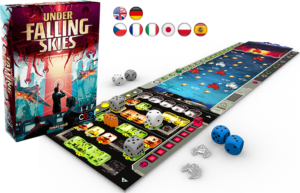 Think Missile Command (the classic arcade game) but more strategic and played with cards and dice. Under Falling Skies has players trying to fend off invading alien ships (and the mothership) by placing one’s dice at the bottom of a tall narrow board. The mothership and its alien fighters slowly work their way down towards the player base at the bottom. Dice placed in the base trigger nice effects, with higher numbers triggering stronger effects. However, the alien fighters also move based off the number on the die. While fending off invading hordes, a player can also improve their base by digging out new (and more powerful) sections to use and conducting research. Complete the research track before being overrun and you win. The small game box belies a pile of nice content. The difficulty can be easily adjusted in many ways, there’s multiple starting base cities – each with their own layout and special power, and even a campaign spanning 10 games over four chapters. Each scenario adds in new problems and often also provides one-off special powers with which to try to weasel your way to freedom. Its a great mix of simple mechanics that give rise to more complex decisions that is all knit together with an Independence Day movie style theme.
Think Missile Command (the classic arcade game) but more strategic and played with cards and dice. Under Falling Skies has players trying to fend off invading alien ships (and the mothership) by placing one’s dice at the bottom of a tall narrow board. The mothership and its alien fighters slowly work their way down towards the player base at the bottom. Dice placed in the base trigger nice effects, with higher numbers triggering stronger effects. However, the alien fighters also move based off the number on the die. While fending off invading hordes, a player can also improve their base by digging out new (and more powerful) sections to use and conducting research. Complete the research track before being overrun and you win. The small game box belies a pile of nice content. The difficulty can be easily adjusted in many ways, there’s multiple starting base cities – each with their own layout and special power, and even a campaign spanning 10 games over four chapters. Each scenario adds in new problems and often also provides one-off special powers with which to try to weasel your way to freedom. Its a great mix of simple mechanics that give rise to more complex decisions that is all knit together with an Independence Day movie style theme.
MicroMacro: Crime City (Pegasus Spiele – $30) 1-4p 15-45 min 12+ yrs
 Technically playable by any number of players, MicroMacro is best played by one or two. It is what happens when someone tries to take a series of Where’s Waldo photographs of a crime scene, and then lay them out on top of each other. Basically, the game is a giant fold-out black and white map of a city full of active bunny-type people. Scattered amongst the metropolis are the results of various nefarious deeds. For example, there may be a dead body on the ground in the trees. Tracking back a block or two, it’s like looking into the past as one can see the past person (now alive) walking towards the park, with a mysterious stranger tailing them. Further sleuthing back along the path might uncover just who this person was and why they were followed. The large table-sized map is full of such examples. The game box comes with a stack of cards which are sorted into small packets. Each packet references a specific “crime” that occurs on the poster and the cards lead a player through their “investigations” as they search the poster for clues. If you ever wanted a deduction game crossed with Where’s Waldo, here’s your chance. While the “game” is fun for all ages, note that the whole point of the game is solving crimes so there will be plenty of poor, dead little animal people lying around just waiting for their life’s mystery to be solved. It’s all in line-drawn cartoon peoples so while there is a bit of “edginess” here and there it shouldn’t be a problem for most families. I recently discovered a sequel is now available: MicroMacro: Crime City 2 – Full House. It claims to have 16 slightly more complex crimes to solve on a brand new map. The cases are now marked with special symbols to help adults steer kids towards the crimes they feel are most appropriate.
Technically playable by any number of players, MicroMacro is best played by one or two. It is what happens when someone tries to take a series of Where’s Waldo photographs of a crime scene, and then lay them out on top of each other. Basically, the game is a giant fold-out black and white map of a city full of active bunny-type people. Scattered amongst the metropolis are the results of various nefarious deeds. For example, there may be a dead body on the ground in the trees. Tracking back a block or two, it’s like looking into the past as one can see the past person (now alive) walking towards the park, with a mysterious stranger tailing them. Further sleuthing back along the path might uncover just who this person was and why they were followed. The large table-sized map is full of such examples. The game box comes with a stack of cards which are sorted into small packets. Each packet references a specific “crime” that occurs on the poster and the cards lead a player through their “investigations” as they search the poster for clues. If you ever wanted a deduction game crossed with Where’s Waldo, here’s your chance. While the “game” is fun for all ages, note that the whole point of the game is solving crimes so there will be plenty of poor, dead little animal people lying around just waiting for their life’s mystery to be solved. It’s all in line-drawn cartoon peoples so while there is a bit of “edginess” here and there it shouldn’t be a problem for most families. I recently discovered a sequel is now available: MicroMacro: Crime City 2 – Full House. It claims to have 16 slightly more complex crimes to solve on a brand new map. The cases are now marked with special symbols to help adults steer kids towards the crimes they feel are most appropriate.
Stockings
Got a bit of space left in your sock over the fireplace? Here’s a great small game that you might be able to cram into the toe, or at least it’s easy on the pocketbook…
We Care: a Grizzled Game (CMON – $20) 2-5p 30min 14+ yrs
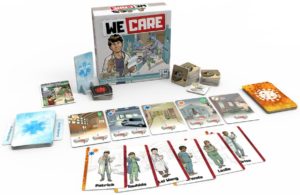 Based on a popular cooperative game about WWI (The Grizzled), We Care has players taking on the role of medical professionals as they struggle to treat infected people fast enough to avoid running out of hospital beds which cause a breakout of the disease. Basically, the game adds specific patient cards to a central area and then the players use cards in their hands to “cure” those patients and clear out more space. Unfortunately, cards drawn by a player are not always good. They can add to the hospital’s problems but, even worse, can affect that medical worker directly – exposing them to the virus or wearing them down emotionally. Either way, that player now needs to look out for ways to rest and recover while still helping the team manage the influx of patients. I like cooperative games and this one has a lot going for it. The theme is spot-on for the current events, and treats the pandemic and the workers on the front lines with sensitivity and respect. It does a great job simulating the personal and professional challenges in dealing with the crisis. As a cooperative game, it fosters a great sense of camaraderie among players as everyone strives to stay on top of things while also trying to help out the team. A small box size and price point are just the cherries on top. This doesn’t mean it is simple or easy to win, there are a lot of things going on and good players need to track what they’re doing, what the central goals are doing, and how their healthcare buddies are doing. The game’s difficulty (win/loss odds) is on the high side, but as with all good games of this type there are ways to adjust the setup to make things easier or harder. The game ticks a lot of my favorite boxes and its timely theme brings a broader learning experience to family game night.
Based on a popular cooperative game about WWI (The Grizzled), We Care has players taking on the role of medical professionals as they struggle to treat infected people fast enough to avoid running out of hospital beds which cause a breakout of the disease. Basically, the game adds specific patient cards to a central area and then the players use cards in their hands to “cure” those patients and clear out more space. Unfortunately, cards drawn by a player are not always good. They can add to the hospital’s problems but, even worse, can affect that medical worker directly – exposing them to the virus or wearing them down emotionally. Either way, that player now needs to look out for ways to rest and recover while still helping the team manage the influx of patients. I like cooperative games and this one has a lot going for it. The theme is spot-on for the current events, and treats the pandemic and the workers on the front lines with sensitivity and respect. It does a great job simulating the personal and professional challenges in dealing with the crisis. As a cooperative game, it fosters a great sense of camaraderie among players as everyone strives to stay on top of things while also trying to help out the team. A small box size and price point are just the cherries on top. This doesn’t mean it is simple or easy to win, there are a lot of things going on and good players need to track what they’re doing, what the central goals are doing, and how their healthcare buddies are doing. The game’s difficulty (win/loss odds) is on the high side, but as with all good games of this type there are ways to adjust the setup to make things easier or harder. The game ticks a lot of my favorite boxes and its timely theme brings a broader learning experience to family game night.
Fantasy Realms (Wizkids – $20) 2-6p, 20 min, 14+ yrs
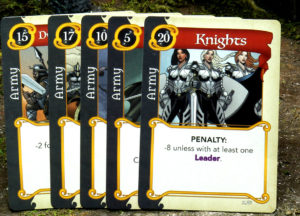 This card game starts deceptively simple, dealing out seven cards to each player who then draw a card (from the deck or discard area.) Then, at the end of their turn they discard a card to the discards (which are spread out, not in a pile.) After ten cards are placed in the discard area the game ends and players score their hands. What makes the game interesting are the special rules and resulting interactions on the individual cards. Cards can give bonuses or penalties to other cards in your hand depending on their value, their suit, or even a specific card. Some cards can “blank” out other cards making them essentially just a piece of paper in your hand. Some cards can “clear” penalties on other cards (and are always applied before any penalties happen.) As one might expect, scoring does take a minute, with the game recommending you score each card individually as you work your way through your hand. With so much going on on the cards, the first game or two can take a bit of time (really 30 minutes tops) as players figure out where they want to head with their hands, but after a hand or two players can run through a game at a brisk pace. (Remember, because players must always draw and discard, the game essentially ends after 10 players have drawn from the deck instead of exchanging with the discard pool.) While the game states ages 14+, it can easily go lower – the game recently won family strategy game of the year in Germany. If the game tickles your fancy, there is an expansion, The Cursed Hoard, which gives every player a cursed item at the start of the game. Upon use, the item is flipped over and serves as a bonus or penalty at the end of the game – items providing a penalty may provide a rather powerful positive effect. For example, a curse item might provide dozens of penalty points, but it permanently increases a player’s hand size by one! The expansion also has three new suits which can be added (either all three or none) to the base game and have new powers that affect the discards and mess with your hand and hand size. The expansion extends the game just a bit, but it is still a fast-playing game suitable for starting or ending an evening of gaming.
This card game starts deceptively simple, dealing out seven cards to each player who then draw a card (from the deck or discard area.) Then, at the end of their turn they discard a card to the discards (which are spread out, not in a pile.) After ten cards are placed in the discard area the game ends and players score their hands. What makes the game interesting are the special rules and resulting interactions on the individual cards. Cards can give bonuses or penalties to other cards in your hand depending on their value, their suit, or even a specific card. Some cards can “blank” out other cards making them essentially just a piece of paper in your hand. Some cards can “clear” penalties on other cards (and are always applied before any penalties happen.) As one might expect, scoring does take a minute, with the game recommending you score each card individually as you work your way through your hand. With so much going on on the cards, the first game or two can take a bit of time (really 30 minutes tops) as players figure out where they want to head with their hands, but after a hand or two players can run through a game at a brisk pace. (Remember, because players must always draw and discard, the game essentially ends after 10 players have drawn from the deck instead of exchanging with the discard pool.) While the game states ages 14+, it can easily go lower – the game recently won family strategy game of the year in Germany. If the game tickles your fancy, there is an expansion, The Cursed Hoard, which gives every player a cursed item at the start of the game. Upon use, the item is flipped over and serves as a bonus or penalty at the end of the game – items providing a penalty may provide a rather powerful positive effect. For example, a curse item might provide dozens of penalty points, but it permanently increases a player’s hand size by one! The expansion also has three new suits which can be added (either all three or none) to the base game and have new powers that affect the discards and mess with your hand and hand size. The expansion extends the game just a bit, but it is still a fast-playing game suitable for starting or ending an evening of gaming.
Power Failure (Genius Games – $15) 2-4p 45 min 8+ yrs
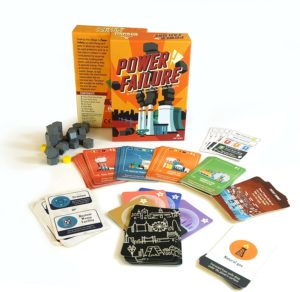 Genius Games puts out educational games that are game first and education second. I was impressed by their offerings last fall at the GenCon convention in September. There was an interesting game revolving around the processes in a giant cell as a game board and am in the midst of checking out a game based around Mendellian genetics. However, I did get to try out the card game Power Failure with my family and this was a fun little take on the idea of clean power generation. Players have three actions to draw cards, play cards, or “activate” their power plants. Plants come in five types (green/wind, nuclear, gas, coal, and oil) and need the requisite (except for green) resource cards to run. Generate enough power from your plants at the end of your turn and you can claim a city card for points. However, burning coal or oil means you’re adding carbon to the environment which means you have to take little hexagonal coal pieces and place them on the “carbon stack.” This is a Jenga-like balancing act where you might need to stack 6 or more little carbon tokens on an already leaning stack. If the stack falls, your turn ends immediately (no city point card for you) and the stack is reset at a stack of three. It isn’t a deep game, players have to make due with what is available on their turns but players must still decide whether to push for points now and pray for steady hands or wait and spend more effort setting up a “safer” play later that might involve fewer tokens or a shorter tower.
Genius Games puts out educational games that are game first and education second. I was impressed by their offerings last fall at the GenCon convention in September. There was an interesting game revolving around the processes in a giant cell as a game board and am in the midst of checking out a game based around Mendellian genetics. However, I did get to try out the card game Power Failure with my family and this was a fun little take on the idea of clean power generation. Players have three actions to draw cards, play cards, or “activate” their power plants. Plants come in five types (green/wind, nuclear, gas, coal, and oil) and need the requisite (except for green) resource cards to run. Generate enough power from your plants at the end of your turn and you can claim a city card for points. However, burning coal or oil means you’re adding carbon to the environment which means you have to take little hexagonal coal pieces and place them on the “carbon stack.” This is a Jenga-like balancing act where you might need to stack 6 or more little carbon tokens on an already leaning stack. If the stack falls, your turn ends immediately (no city point card for you) and the stack is reset at a stack of three. It isn’t a deep game, players have to make due with what is available on their turns but players must still decide whether to push for points now and pray for steady hands or wait and spend more effort setting up a “safer” play later that might involve fewer tokens or a shorter tower.
Expansions
If you already have favorite games in your collection, you may be pleasantly surprised to find there are expansions available to breathe new life into old favorites. Here are a few I like that expand some of the meatier games I’ve recommended in the past.
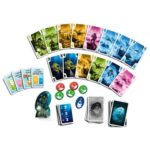 The cooperative trick taking game (think Bridge with everyone on the same team) I loved last year is back in a sequel: The Crew: Mission Deep Sea (Kosmos). It’s more of the same where the players have to play tricks to make sure the right player gets the correct card(s). Fans of the original think this one is even better.
The cooperative trick taking game (think Bridge with everyone on the same team) I loved last year is back in a sequel: The Crew: Mission Deep Sea (Kosmos). It’s more of the same where the players have to play tricks to make sure the right player gets the correct card(s). Fans of the original think this one is even better.
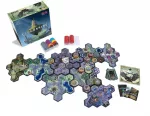 The very deep strategy game from two years ago, Cloudspire (Chip Theory Games), is back with two new expansions. Cloudspire attempts to capture the MOBA video game genre (think League of Legends) as a boardgame. Players send out stacks of creeps and heroes at the other players, hoping to damage their base. This highly asymmetrical game (every player has significantly different powers) now has two new factions; The Uprising is a mishmash of mercenaries banding together (they can also be used in the general “store” area during other games,) while Horizon’s Wrath has a faction acting like pirates, stealing from other factions and even having a mobile fortress. I like how both expansions come with four new solo scenarios and two cooperative ones.
The very deep strategy game from two years ago, Cloudspire (Chip Theory Games), is back with two new expansions. Cloudspire attempts to capture the MOBA video game genre (think League of Legends) as a boardgame. Players send out stacks of creeps and heroes at the other players, hoping to damage their base. This highly asymmetrical game (every player has significantly different powers) now has two new factions; The Uprising is a mishmash of mercenaries banding together (they can also be used in the general “store” area during other games,) while Horizon’s Wrath has a faction acting like pirates, stealing from other factions and even having a mobile fortress. I like how both expansions come with four new solo scenarios and two cooperative ones.
 Last year’s Super Skill Pinball (Wizkids), the roll & write game that does a great job of simulating pinball, is back with four new game boards in Ramp it Up! Each adds in new mechanisms, including using the “backglass” portion of the game board for additional loops and ramps. I particularly like the board that has two players cooperating side-by-side as they play the game together to maximize points.
Last year’s Super Skill Pinball (Wizkids), the roll & write game that does a great job of simulating pinball, is back with four new game boards in Ramp it Up! Each adds in new mechanisms, including using the “backglass” portion of the game board for additional loops and ramps. I particularly like the board that has two players cooperating side-by-side as they play the game together to maximize points.
 From further back in time, Space Base (a board-less Monopoly type game, similar in genre to Machi Koro) was a recommendation. The Emergence of Shy Pluto (Alderac Entertainment Group – AEG) is a more recent expansion but rather than just adding content it sets up a series of story based scenarios that introduce the expansion’s new content by playing through a larger story arc.
From further back in time, Space Base (a board-less Monopoly type game, similar in genre to Machi Koro) was a recommendation. The Emergence of Shy Pluto (Alderac Entertainment Group – AEG) is a more recent expansion but rather than just adding content it sets up a series of story based scenarios that introduce the expansion’s new content by playing through a larger story arc.
Conclusions
No matter what toys and presents the holidays bring, be sure to keep time in your schedule for playing with friends and family. While the games here come highly recommended to provide fun for a wide range of players, there are plenty other choices available. Ask your local game store, a boardgaming friend, or check some of our past recommendations.
(*Disclaimer, many of these games were provided by the publishers for review purposes. Of course, there were plenty others who didn’t make the cut.)





Discussion Area - Leave a Comment